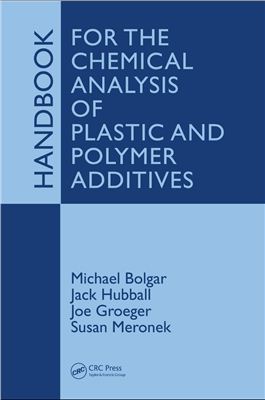CRC Press. 2008. 498 p.
Most plastics and polymers used for consumer goods and technical applications contain numerous additives, many of which are potentially hazardous to human health and the environment. The Handbook for the Chemical Analysis of Plastic and Polymer Additives provides a detailed reference for the analysis of additives that are most widely used in plastics and polymers.
The handbook offers a unique combination of comprehensive chromatograms, mass spectral data, and analytical data in addition to environmental perspectives and regulations issued by the FDA, USEPA, EU agencies, and other groups. Unlike other resources that focus on the selection of performance-enhancing additives, this book provides the information and techniques needed to extract, identify, and quantify additives in finished goods using common and readily available laboratory techniques. This makes it an ideal reference for monitoring plastics for regulatory or inteal compliance applications as well as for using analysis to troubleshoot, develop, or improve upon application-specific compounding practices and processes.
Encouraging the development of protocols for analyzing plastics and polymers, this handbook presents a clear guide to viable isolation techniques and analysis methods for accurately assessing plastic and polymer mixtures as well as an up-to-date review of the most widely used and representative additives and their known toxicological impact.
Contents
Preface
How to Use this Handbook
Overview of Polymers, Additives, and Processing
Extraction and Analysis
Accelerators
Antidegradants
Antioxidants
Coupling Agents
Flame Retardants
Plasticizers
Other Compounds of Interest
Real World Problems Related to Additives
Most plastics and polymers used for consumer goods and technical applications contain numerous additives, many of which are potentially hazardous to human health and the environment. The Handbook for the Chemical Analysis of Plastic and Polymer Additives provides a detailed reference for the analysis of additives that are most widely used in plastics and polymers.
The handbook offers a unique combination of comprehensive chromatograms, mass spectral data, and analytical data in addition to environmental perspectives and regulations issued by the FDA, USEPA, EU agencies, and other groups. Unlike other resources that focus on the selection of performance-enhancing additives, this book provides the information and techniques needed to extract, identify, and quantify additives in finished goods using common and readily available laboratory techniques. This makes it an ideal reference for monitoring plastics for regulatory or inteal compliance applications as well as for using analysis to troubleshoot, develop, or improve upon application-specific compounding practices and processes.
Encouraging the development of protocols for analyzing plastics and polymers, this handbook presents a clear guide to viable isolation techniques and analysis methods for accurately assessing plastic and polymer mixtures as well as an up-to-date review of the most widely used and representative additives and their known toxicological impact.
Contents
Preface
How to Use this Handbook
Overview of Polymers, Additives, and Processing
Extraction and Analysis
Accelerators
Antidegradants
Antioxidants
Coupling Agents
Flame Retardants
Plasticizers
Other Compounds of Interest
Real World Problems Related to Additives

